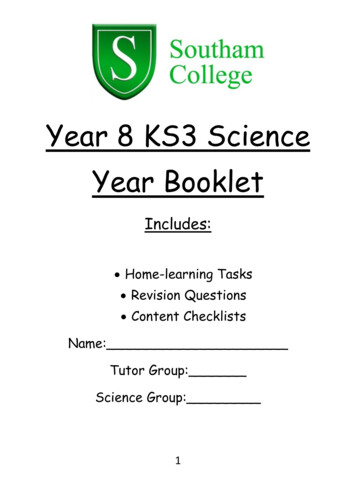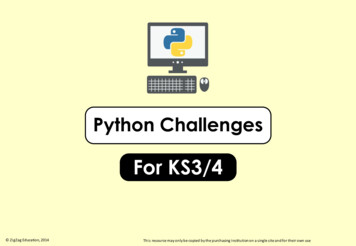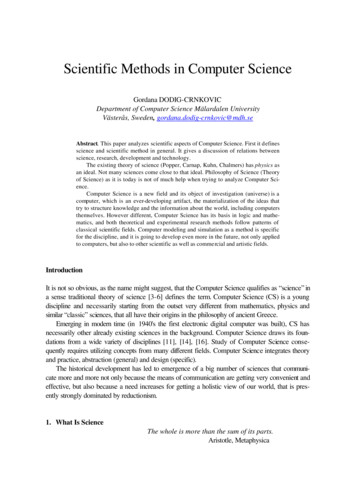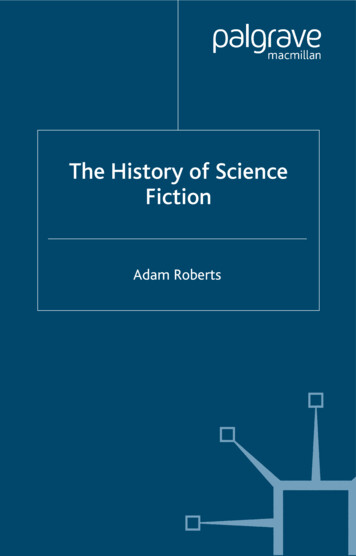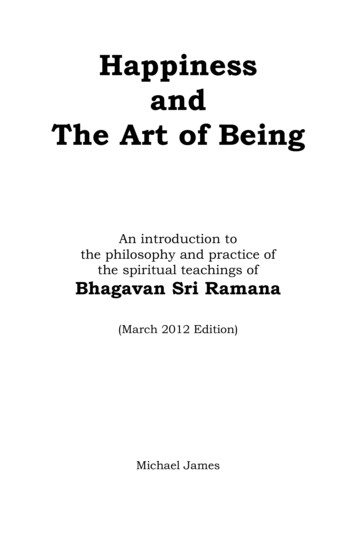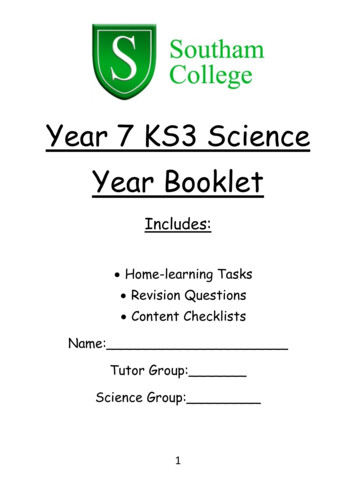
Transcription
Year 7 KS3 ScienceYear BookletIncludes: Home-learning Tasks Revision Questions Content ChecklistsName:Tutor Group:Science Group:1
Contents:Pg: 4 - 97B1: CellsPg: 10 - 14 7C1: Particles and their BehaviourPg: 15 - 20 7P4: SpacePg: 21 - 26 7B2: Structure and Function of Body SystemsPg: 27 -30 7C2: Elements, atoms and compoundsPg: 31-367P1: ForcesPg: 37-427B3: ReproductionPg: 43-477C3: ReactionsPg: 48-537P2: SoundPg: 54-587C4: Acids and AlkalisPg 59 - 66 7P3: Light2
FAQs.How many home-learning tasks will I need to do?One a week, which should cover 3 tasks per unit.How will I know which task to complete?Your teacher will tell you which unit and task number to complete. But youare expected to complete the challenge task for each home-learning set.What if I find the challenge task too hard?We want to challenge you to increase your progress during the year, but ifyou do find it too hard, get your tutor or a parent to make and sign a note inyour science book by your home-learning and complete the regular task. Youwill need to do this each time.What do I do if I don’t get it?Go and talk to your teacher (or any science teacher) before the due date,we are here to help. There are revision resources in this book to help,otherwise try www.bbcbitesize.co.uk or buy a revision guide from thescience lab technicians.Can I do my home-learning on the computer?Yes. But make sure you print it out and stick it in your book. If you arrive toyour lesson with it on a memory stick, it will not be accepted.Can I complete the tasks ahead of them being set?Yes! Make sure it is easy for your science teacher to find it in your bookWhat are the revision questions and checklists for?It is important to revise before each assessment. Use the checklists to findout if there are any areas you may need to work on before a test and therevision questions to get someone else or to test yourself on the topic.3
7B1: CellsTextbook pages 14-254
7B1: Home-Learning Tasks:TaskRegularChallengeDraw a picture of a microscope.Give a step by step instruction to aLabel the eyepiece, objective lens,year 7 student on how to use thestage, light and focus.microscope to see a slideResearch a muscle cell. Draw aResearch a phagocyte Draw adiagram of the cell, describe itsdiagram of the cell, describe itsfunction, describe where it is foundfunction, describe where it is foundand explain how it is adapted to itsand explain how it is adapted to itsfunction.function.Research a cilia cell. Draw aResearch what stem cells are.diagram of the cell, describe itsDescribe what they are, whatfunction, describe where it is foundscientists want to do with stemand explain how it is adapted to itscells and the for and againstfunction.arguments of what stem cells areCompleted?Number123used for4Summary Questions: RegularSummary Questions: ChallengeSummary Questions: Regular:1. Describe what these parts of a cell do: a) A nucleus b) Cell membrane c) Chloroplast2. Draw and label a diagram of a sperm cell. Explain how its streamlined head and tail helps thesperm cell3. Draw and label a diagram of an egg cell (Ovum). Explain how its streamlined head and tail helps thesperm cell4. Describe what diffusion is. Give an example of itSummary Questions: Challenge:1.2.3.4.5.Describe what the nucleus of a cell doesDescribe the similarities and differences between plant and animal cellsExplain how substances get in and out of cellsDescribe what red blood cells do and explain how they are adapted to their functionExplain using the correct parts of a cell, why plants can wilt if they have not been wateredproperly5
7B1: Revision Questions:1.2.3.4.QuestionWhat are all living organisms made upfrom?Who was the first person so look downa microscope?What does “making an observation”mean?Name the 7 parts of a microscope5. How do you calculate totalmagnification when looking down amicroscope?6. Name the four parts of an animal cell7. Name the seven parts of a plant cell8. Which part of the cell controls thecell and contains the geneticinformation?9. What happens in the mitochondria10. What happens in the chloroplasts11. What happens in the cytoplasm12. What does the cell membrane do?13. What are specialised cells?14. How is a nerve cell adapted to do itsjob?15. How are red blood cells adapted to dotheir job?16. How are sperm cells adapted to dotheir job?17. How are leaf cells adapted to do theirjob?18. How are root hair cells adapted to dotheir job?19. What substances are needed forrespiration?20. What is diffusion?AnswerCellsRobert HookeLooking carefully and in detail at an objectEyepiece, objective lens, stage, slide, fine focussingwheel, coarse focussing wheel, lightTotal magnification eyepiece lens magnification xobjective lens magnificationCell membrane, cytoplasm, nucleus, mitochondrionChloroplast, vacuole, cytoplasm, mitochondrion, cellwall, cell membrane, nucleusNucleusRespirationPhotosynthesisCell reactionsControls substances entering and leaving the cellCells that have become specially adapted to do acertain jobIt is long and thin and has connections at both endsto pass messages onto other nerve cellsThey have a disk like shape to increase their surfacearea so they can carry more oxygenThey have a tail to help them swim. They have lots ofmitochondria to give them enough energy.They have lots of chloroplasts in them to absorbsunlight.They have a large surface area to absorb water andnutrients. They do not have chloroplasts in them asthey are found underground so no photosynthesis cantake placeGlucose and oxygenWhen particles move from a place where there is ahigh concentration of them to a place where there isa low concentration of them.6
21. Why do plants wilt?22. What is a unicellular organism?23. How do Amoebas reproduce?24. How does a Euglena move about?25. How does an Amoeba eat?26. How does a Euglena eat?When a plant has not been watered there is not muchwater in each cell. Normally the vacuole is full andthis pushes each cell outwards and makes the plantstand upright. If there is not much water then thevacuole shrinks and the plants wilt.A organism made up from only one cellBy binary fission (they split into two new cells)Using a tail called a flagellumThey eat algae, bacteria and plant cells. Theysurround tiny particles of food engulf these particlesinto a food vacuole.Euglenas contain chloroplasts so they can make theirown food by photosynthesis. If there is not enoughlight then they can eat other microorganisms myengulfing them.7
7B1: Checklist:Topic1.1Page1415Spec pointsObserving Cells: I can describe what cells are I can name some equipment that 1.21617 1819may be used to observe cellsI can describe the differentparts of a microscopeI can calculate the magnificationof a microscopePlant and animal cells: I can list the main parts of cells I can identify parts of a cell from 1.3Understandinga diagramI can accurately draw parts ofcells when viewing them under amicroscopeI can describe the functions ofthe main parts of cellsI can compare and contrast animaland plant cellsSpecialised Cells: I can identify differentspecialised cells I can describe the structuraladaptations of some animal andplant cells (nerve, red blood,sperm, leaf and root hair)I can explain how theadaptations of cells improvestheir functionMovement of substances: I can describe the process of 1.42021 diffusion and where it is usedI can suggest how the rate ofdiffusion may be affectedI can describe the substancesthat move across cell membranesI can give examples of diffusion8RevisedRP
1.52223I can explain why plants wilt interms of cell structureI can describe what osmosis is Unicellular Organisms: I can identify the structural adaptations of some unicellularorganismsI can describe what a unicellularorganism isI can describe the structure ofamoeba and euglenaI can explain how adaptationshelp unicellular organismsfunctionI can explain how unicellularorganisms eat and reproduce9
7C1: Particles andtheir BehaviourTextbook pages 60-7510
7C1: Home-Learning Tasks:TaskRegularChallengeDraw a picture of particles in solids,Draw and explain in detail howliquids and gases.particles behave in the 3 states ofCompleted?Number1matter.2Draw on graph paper the coolingResearch and then explain why thecurve of steric acid when ittemperature remains constant whenfreezes. Label on the diagram whena change of state occurs.a change of stare occurs.3Research the terms sublimation,Investigate different examples ofcondensation and diffusion. Explaindiffusion. Explain why the rate ofwhat they mean.diffusion increases withtemperature. Investigate and giveexamples of materials that undergosublimation.4Summary Questions: RegularSummary Questions: ChallengeSummary Questions: Regular:1. Describe the arrangement and movement of particles in the liquid state.2. Explain the different diffusion speeds through substances in solid, liquid andgas.3. Explain why a balloon would get bigger as it gains altitude.4. Explain why a balloon would get bigger as it gets hotter.Summary Questions: Challenge:1. Investigate and explain what the kinetic theory of gases states.2. Investigate and explain what the term latent heat of fusion means.3. Investigate and explain why a plastic bottle would appear to shrink if it wasplaced into a freezer.4. Neon has a boiling point of -249 degrees Celsius. Explain what would happento the particles as it is slowly heated from -255 degrees Celsius to -245degrees Celsius.11
7C1: Revision Questions:QuestionWhat are materials made of?What is a mixture?What do the properties of a substancedepend on?What are three states of matter?What are the properties of a solid?What are the properties of a liquid?What are the properties of a gas?Describe the structure of a solidDescribe the structure of a liquidDescribe the structure of a gasWhat are the solid/liquid state changes?Describe what happens to the particles as icemeltsWhat is a melting point?How can a melting point tell us about theidentity of a substance?How can a melting point tell us about thepurity of a substance?What is boiling?What is the boiling point?How can a boiling point tell us about theidentity of a substance?What is evaporation?When might evaporation be useful?What is condensation?What is sublimation?What is diffusion?What factors affect diffusion speed?What causes pressure?How does the number of particles affectpressure?How does temperature affect pressure?AnswerParticlesA mixture is made of different types of particlesThe particlesSolid, liquid, gasUncompressible, doesn’t flow, fixed shapeUncompressible, does flow, takes the shape of itscontainerCompressible, does flow, fills its containerTouching their neighbours, in a regular pattern,vibrate in place, don’t move aroundTouching neighbours with gaps, may move aroundNot touching neighbours, moving constantlyMelting and freezingThey gain energy and vibrate faster, they move outof their places so the ice meltsThe temperature at which a substance meltsEach substance has a specific melting pointA pure substance has a sharp melting pointThe state change from liquid to gasThe temperature at which a liquid boilsEach substance has a specific boiling pointChanging from liquid to gas without boilingSweating to cool downState change from gas to liquidState change from solid to gas without going to liquidThe random movement of particles through air orliquid to spread out.Temperature, particle size, state of the diffusingsubstanceParticles colliding with the container wallMore particles more collisions higher pressureHigher temperature more energy faster particles more collisions higher pressure12
7C1: Checklist:TopicPage1.160611.26263Spec pointsThe Particle Model: I can describe what a particleis I can use the particle modelto explain why differentmaterials have differentpropertiesStates of Matter: I can name the three states of 1.36465 6667matterI can describe the properties ofthe three states of matterI can represent the three statesof matter with drawings ofparticlesI can explain the properties of thethree states of matter withreference to the particle modelMelting and Freezing I can list the changes of states I can describe how changes of 1.4Understandingstates may occurI can explain changes of states ofmatter with reference to energylevels of particlesI can describe what is meant bythe melting point of a substanceI can describe how you can usemelting points to check thepurity of a substanceI can recall what happens to thetemperature of a heatedsubstance when it is meltingBoiling: I can list the changes of states I can describe how changes ofstates may occur13RevisedRP
I can explain changes of states ofmatter with reference to energylevels of particlesI can describe changes of stateswith reference to energy changesI can describe how tomeasure the boiling point of asubstance I can predict the state of asubstance at a certaintemperature using the boilingand melting pointChanges of State: I can describe what is meantby evaporation, sublimationand condensation I can explain what happens inevaporation, sublimation andcondensation in terms ofparticles and energy I can explain how evaporationis usefulDiffusion: I can state that particles may 1.568691.67071 1.77273move through a fluid by diffusionI can describe diffusion in termsof the particle modelI can explain how diffusionhappens in terms of the particlemodelI can suggest how the rate ofdiffusion may be affectedGas Pressure: I can describe how pressure occurs in gasesI can explain how pressure ingases may change14
7P4: SpaceTextbook pages 148-15715
7P4: Home-Learning Tasks:Research Project:You need to use the internet, class text books or from any information providedto research answers to the following:Regular: Describe how the Moon was formed and explain what evidence we have forthis Describe the difference between a meteor and a meteorite. Explain theconsequences of a meteorite colliding with Earth Describe how we explore space through landers, probes and rovers Describe what an asteroid is and what an asteroid belt isChallenge: Describe what a star is Describe the formation of a star from a Nebula and explain the possiblefate of stars Describe what black holes are and describe some of their properties Describe what dark matter and dark energy areTo submit to your teacher:You need to produce in your book:- The research questions answered with the questions as subtitles- A full bibliography of where you obtained your findings- A system to reference your work (Harvard referencing)- Page numbers if necessary16
7P4: Revision Questions:Question1. What is an artificial satellite?2. What does orbit mean?3. How do we see the moon?4. What is a comet? What is it made from?5. What are asteroids?6. What is the difference between a meteorand a meteorite?7. How does an asteroid become a meteor?8. What is a star?9. What is a galaxy?10. What is the universe?11. What is the shape of a planet’s orbit?12. What is an ellipse?13. What is the order of the planets, startingfrom the closest to the Sun?14. What are the 4 terrestrial planets?15. Which planets are the gas giants?16. Between which two planets is the asteroidbelt?17. What is a dwarf planet? Give an example18. How did the universe form?19. Describe the motion of the Earth20. At what angle does the Earth tilt on itsaxis21. What is a year? How long is Earth’s?22. What is a day? How long is Earth’s?23. What are the 4 different seasons?24. What causes summer?25. What causes winter?26. What is a constellation?27. Why does the moon look different atdifferent times of the month?AnswerA manmade satelliteThe path taken by one body in space as it movesaround another body(It is non-luminous). Light reflects off it from theSunIt is a body made up of ice and rock that orbits theSun (in an elliptical orbit)Lumps of rock orbiting the Sun left over from whenthe Solar system was formedA meteor is a rock that burns up in our atmosphere. Ameteorite is a rock that collides with Earth.The asteroids collide into each other, knocking themout of orbit. They then start moving towards planetsA large ball of gas that emits light and heat in spaceA large collection of stars and Solar systemsEverything that existsAn ellipseA squashed circle (an oval)Mercury, Venus, Earth, Mars, Jupiter, Saturn,Uranus, NeptuneMercury, Venus, Earth, MarsJupiter, Saturn, Uranus, NeptuneMars and JupiterA small lump of rock that orbits the Sun. Pluto.It rotates on its axis23.4 Time taken for a planet to orbit the Sun: 365.25 daysTime taken for a planet to make one completerotation: 24 hoursWinter, spring, summer, autumnWhen that part of the Earth is tilted towards theSun (as the sun is concentrated on a smaller area)When that part of the Earth is tilted away the Sun(as the sun is spread out over a larger area)A collection of stars that makes a patternIts position around the Earth changes. It creates ashadow on part of the Moon17
28. What is meant by the different phases of The changing shapes of the Moonthe moon?29. What is a lunar month?The time taken for the Moon to orbit the Earth(around 28 days)30. What is a solar eclipse?An eclipse where the moon comes between the Sunand the Earth31. What is a lunar eclipse?An eclipse that happens when the Earth comesbetween the Sun and the Moon32. What is an umbra?The area of total shadow behind an opaque objectwhere no light has reached33. What is a penumbra?The area of blurred shadow around the edge of theumbra34. What is a satellite?A body that orbits another body35. Give an example of a natural satelliteThe Moon18
7P4: Checklist:TopicPageSpec pointsUnderstanding4.1148149The Night Sky: I can explain that our Sun is a150151I can describe what comets,meteors, meteorites, planets,galaxies, satellites areThe Solar System: I can identify gravity as the forcestar, and that there are otherstars and solar systems in ourgalaxy and other galaxies in theUniverse 4.2 4.3152153which exists between the Moonand the Earth and between theSun and the EarthI can list planets in our solarsystem in orderI can describe a solar system as acollection of plants and otherobjects orbiting a starI can describe the main theoryfor how our solar system formedTo describe the differencebetween terrestrial planets andgas giantsThe Earth: I can state the length of an Earth dayI can state the length of an EarthyearI can state that the Earth istilted on its axisI can list the seasons of the Earthin orderI can describe what a day isI can describe a year isI can explain what causes seasonsI can explain the existence of a19RevisedRP
4.4154155leap year, with reference to thefact that an earth year is actually365.25 daysI can explain how the differentseasons occur in the northernhemisphere, with reference to thetilt of the Earth and proximity tothe SunI can apply knowledge of theseasons in the northernhemisphere to explain why thesouthern hemisphere experiencesseasons differentlyThe Moon: I can state that on Earth, a lunar month is 28 daysI can describe what a Solar andLunar eclipse isI can explain what causes Solarand Lunar eclipsesI can describe what an umbraand penumbra areI can explain why we seedifferent phases of the Moon.I can explain why we only seeone side of the Moon from theEarth20
7B2: Structure &Function of BodySystemsTextbook pages 26-3921
7B2: Home-Learning Tasks:TaskRegularChallengeCompleted?Number1Draw a Levels of OrganisationDraw a levels of organisationtriangle for the respiratory systemdiagram for the transport system inplants2Write a story outlining the journeyDescribe as a list the movements ofof an oxygen molecule from the airthe chest when inhaling andto the muscles of a running rabbitexhaling. Include the changes involume and pressure in the chestcavity3Describe how the named muscles ofExplain the role of the ligaments,your arm move the bones whentendons, cartilage and synovial fluidlifting an object from the floor toin the knee jointthe table4Summary Questions: RegularSummary Questions: ChallengeSummary Questions: Regular:1)2)3)4)Describe a) a tissue b) an organ c) an organ system in a humanDescribe the role of the rib muscles and diaphragm muscles in breathingDescribe the role of a) skeleton b) muscles c) jointsExplain the difference between breathing and respirationSummary Questions: Challenge:1) Explain why multi-cellular organisms have many organ systems whereasunicellular organisms do not2) Explain what would happen to breathing if the chest cavity was punctured3) Describe and explain the different composition of breathed in andbreathed out air4) Explain how the antagonistic muscles in the leg move when we take a step22
7B2: Revision Questions:Question1. What are multi-cellular organisms?2. List the 5 levels of organisation inmulti-cellular organisms from smallestto largest3. Explain what a tissue is4. Explain what an organ is5. Explain what an organ system is6. Explain what an organism is7. What job do your lungs do?8. What parts of the body does air haveto pass through before the oxygen init can get into the blood?9. What are alveoli?10. What is breathing in called?11. What is breathing out called?12. Give two differences between inhaledand exhaled air.13. When you breathe in what happens tothe muscles in your chest?14. When you breathe in what happens toyour diaphragm?15. When you breathe in what happens tothe volume in your lungs?16. When you breathe in what happens tothe pressure in your chest?17. When you breathe out what happensto the muscles in your chest?18. When you breathe out what happensto your diaphragm?19. When you breathe out what happensto the volume in your lungs?20. When you breathe out what happensto the pressure in your chest?AnswerOrganisms made up of many cellsCells tissues organs organ systems organismA group of similar cells working together to performa particular functionAn organ is made up of a group of different tissuesthat work together to perform a certain functionAn organ system is a group of different organs thatwork together to perform a certain functionAn organism is made up of several organ systemsworking together to perform all the processesneeded to stay aliveThey are responsible for gas exchange – they take inoxygen and remove carbon dioxide from the bodyNose/mouth trachea bronchus bronchiole alveolus bloodTiny air sacs found in the lungs. They create a largesurface area for gas exchange.InhalingExhalingInhales air contains more oxygen.Exhaled air contains more carbon dioxide.They contractIt contracts and moves downIt increasesIt decreases – this pulls air into your lungsThey relaxIt relaxes and moves downIt decreasesIt increases and pushes air out of your lungs23
21. List three factors that decrease yourlung volume22. How many bones are there in theaverage adult human skeleton?23. List the four main functions of theskeleton24. Where is bone marrow found?25. What does bone marrow do?26. What is a joint?27. Name the three types of joint.28. Give an example of a hinge joint29. Give an example of a ball and socketjoint30. Give an example of a fixed joint31. What is the job of cartilage?32. What is the job of ligaments?33. What is the job of tendons?34. What does antagonistic mean?Smoking, asthma and old age206Support the body, protect organs, help the bodymove, make blood cellsIn the middle of some of the longer bones such as inyour arms and legsMakes new blood cellsWhere two or more bones join togetherHinge joints, ball and socket joints, fixed jointsElbow or kneeHip or shoulderThe skullThis covers the ends of bones and stops themrubbing together and causing painThis holds the bones togetherThis attaches the muscle to the boneThis is when a pair of muscles works opposite eachother to move the body. For example the biceps andtriceps. When the biceps contracts the tricepsrelaxes and when the triceps relaxes the bicepsrelaxes. This allows your arm to move up and down.24
7B2: Checklist:Topic2.1Page2627Spec pointsLevels of Organisation: I can describe what a multicellular organism is I can list and identify different 2.22829 3031tissues and organsI can describe how multicellularorganisms are organised (cells tissues organs organ systems organisms)I can describe a tissue, an organand an organ systemI can name some organs and organsystems in humansI can describe the job of someorgan systemsGas Exchange: I can name some tissues and 2.3Understandingorgans in the human gas exchangesystemI can label a simple diagram of thehuman gas exchange systemI can describe the functions ofsome tissues and organs in thehuman gas exchange systemI can compare the amounts ofgases in inhaled air to exhaledairI can explain why you can seeyour breath on a cold mirrorI can explain how the breathingsystem is adapted to its functionBreathing: I can state what happens to the air, ribs and diaphragm duringbreathingI can describe changes in lungvolume during breathing25RevisedRP
2.43233Skeleton: I can identify parts of the 2.53435I can describe how to measurelung volumeI can explain how models candemonstrate how the lungs workskeletal systemI can describe the individualfunctions of parts of the skeletalsystemI can describe the function ofbonesI can explain how blood cells aremadeMovement: Joints: I can describe methods of measuring the force from musclesI can explain why some musclesmay need to be stronger thanothersI can describe the function ofcartilage and ligaments I can recall the differenttypes of jointMovement: Muscles: I can identify parts of the 2.63637 muscular systemI can describe the individualfunctions of parts of the muscularsystemI can explain how parts of theskeletal and muscular system worktogetherI can explain the function ofantagonistic muscle pairs26
7C2: Elements,atoms andCompoundTextbook pages 76-8527
7C2: Home-Learning Tasks:TaskRegularChallengeDefine the term element. ResearchInvestigate the term element andhow many types of elements exist inlist the first 20 elements in orderthe world.of their atomic number.Investigate the term compound.Research the difference betweenExplain the differences betweenthe term covalent compound andelements and compounds.ionic compound.State the number of each type ofDraw and label diagrams to showatom in H2O, H2, H2SO4how you could make models of theCompleted?Number123molecules: H2O, H2, H2SO44Summary Questions: RegularSummary Questions: ChallengeSummary Questions: Regular:1. Carbon dioxide is a compound made up out of which two elements?2. Write the formula of sulphur dioxide.3. Find the formula of sulphuric acid. State whether it is an element or acompound.4. Investigate who designed the modern periodic table.Summary Questions: Challenge:1. The periodic table shows elements in order of their atomic number.Investigate the difference between the term atomic number and relativeatomic mass.2. Investigate what elements exist in group1. Research their melting points.What trend do you notice in their melting point as you descend the group?3. What group do the Halogens exist in? List the first 3 halogens andcomment on the trend in their boiling points as you descend the group.28
7C2: Revision Questions:QuestionWhat is an element?What is used to organise the elements?What is a chemical symbol?What is an atom?Does one atom on its own have the propertiesof an element?What is a compound?What molecules?What happens to the chemical propertieswhen atoms form compounds?What is a chemical formula?How many elements are there?AnswerA substance made of only one type of atomThe periodic tableThe one or two letter code for an elementThe smallest part of an element that can existNoTwo or more different types of atom joined togetherAtoms joined togetherThe chemical properties changeIt shows the relative numbers of each atom in acompound92 29
7C2: Checklist:Topic2.1Page7677Spec pointsElements: I can list examples of atoms, 2.27879Understandingelements and compoundsI can represent elements usingchemical symbolsI can describe what an elementisAtoms: I can recognise an atomic model I can describe what an atom is I can describe the differencebetween atoms2.38081Compounds: I can describe the differences 2.48283between atoms, elements andcompoundsI can describe the properties ofsalt (sodium chloride)Chemical Formulae: I can represent compounds using chemical formulaeI can represent various chemicalreactions using formulae andsymbol equationsI can compare differentcompounds30RevisedRP
7P1: ForcesTextbook pages 112-12331
7P1: Home-Learning Tasks:TaskRegularChallengeFind out what the dead sea is.Describe what Newton’s 3rd law is.Describe what happens when youDescribe an example of it happeningCompleted?Number1are in the dead sea and explain whythis happens234Describe the different ways thatDescribe what these athletes do tocars and other vehicles use toincrease their speed, explain how itincrease their top speed. Explainworks and use pictures a) Cyclists b)how this makes them fasterSnowboarders c) SwimmersDescribe at least 3 differentIn terms of forces describe whatmethods that very fast cars use tohappens to a skydiver as they jumpslow them down. Explain how theyout of a plane. Describe what isworkmeant by terminal velocitySummary Questions: RegularSummary Questions: ChallengeSummary Questions: Regular:1.2.3.4.5.6.Describe the difference between a contact and a non-contact force. Give examples of eachDescribe what happens if you double the force applied to stretch a springDescribe what is meant by an object’s elastic limitDescribe what friction is. Describe a situation where friction is and is not usefulDescribe what happens to an object when the forces acting on it are balancedDescribe what you can do to decrease the air resistance acting on somethingSummary Questions: Challenge:1. A spring has a spring constant of 5 N/cm and is stretched by 4 cm. What force is required todo this?2. Ex
Go and talk to your teacher (or any science teacher) before the due date, we are here to help. There are revision resources in this book to help, otherwise try www.bbcbitesize.co.uk or buy a revision guide from the science lab technicians. Can I do my home-learning on the computer? Yes.
